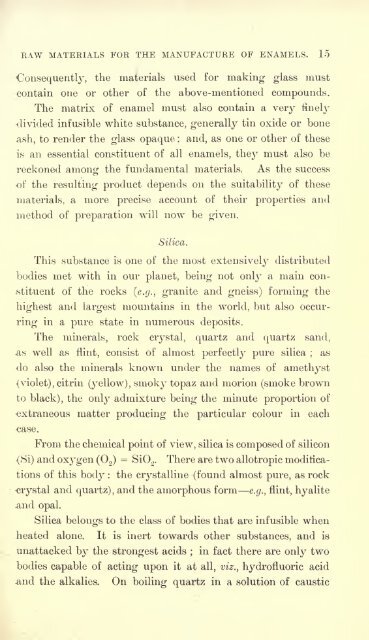Enamels and enamelling; an introduction to the preparation and ...
Enamels and enamelling; an introduction to the preparation and ...
Enamels and enamelling; an introduction to the preparation and ...
You also want an ePaper? Increase the reach of your titles
YUMPU automatically turns print PDFs into web optimized ePapers that Google loves.
BAW MATERIALS FOR THE MANUFACTURE OF ENAMELS. 15<br />
Consequently, <strong>the</strong> materials used for making glass must<br />
contain one or o<strong>the</strong>r of <strong>the</strong> above-mentioned compounds.<br />
The matrix of enamel must also contain a very finely<br />
divided infusible white subst<strong>an</strong>ce, generally tin oxide or bone<br />
ash, <strong>to</strong> render <strong>the</strong> glass opaque :<br />
<strong><strong>an</strong>d</strong>, as one or o<strong>the</strong>r of <strong>the</strong>se<br />
is <strong>an</strong> essential constituent of all enamels, <strong>the</strong>y<br />
must also be<br />
reckoned among <strong>the</strong> fundamental materials. As <strong>the</strong> success<br />
of <strong>the</strong> resulting product depends on <strong>the</strong> suitability of <strong>the</strong>se<br />
materials, a more precise account of <strong>the</strong>ir properties <strong><strong>an</strong>d</strong><br />
method of <strong>preparation</strong> will now be given.<br />
Silica.<br />
This subst<strong>an</strong>ce is one of <strong>the</strong> most extensively distributed<br />
bodies met with in our pl<strong>an</strong>et, being not only a main con-<br />
stituent of <strong>the</strong> rocks (e.g., gr<strong>an</strong>ite <strong><strong>an</strong>d</strong> gneiss) forming <strong>the</strong><br />
highest <strong><strong>an</strong>d</strong> largest mountains in <strong>the</strong> world, but also occur-<br />
ring in a pure state in numerous deposits.<br />
The minerals, rock crystal, quartz <strong><strong>an</strong>d</strong> quartz s<strong><strong>an</strong>d</strong>,<br />
as well as flint, consist of almost perfectly pure silica ; as<br />
do also <strong>the</strong> minerals known under <strong>the</strong> names of amethyst<br />
(violet), citrin (yellow), smoky <strong>to</strong>paz <strong><strong>an</strong>d</strong> morion (smoke brown<br />
<strong>to</strong> black), <strong>the</strong> only admixture being <strong>the</strong> minute proportion of<br />
extr<strong>an</strong>eous matter producing <strong>the</strong> particular colour in each<br />
case.<br />
From <strong>the</strong> chemical point of view, silica is composed of silicon<br />
{Si) <strong><strong>an</strong>d</strong> oxygen (O 2 ) = SiO 2 . There are two allotropic modifica-<br />
tions of this body : <strong>the</strong> crystalline (found almost pure, as rock<br />
-crystal <strong><strong>an</strong>d</strong> quartz), <strong><strong>an</strong>d</strong> <strong>the</strong> amorphous form -e.g., flint, hyalite<br />
<strong><strong>an</strong>d</strong> opal.<br />
Silica belongs <strong>to</strong> <strong>the</strong> class of bodies that are infusible when<br />
heated alone. It is inert <strong>to</strong>wards o<strong>the</strong>r subst<strong>an</strong>ces, <strong><strong>an</strong>d</strong> is<br />
unattacked by <strong>the</strong> strongest acids ;<br />
in fact <strong>the</strong>re are only two<br />
bodies capable of acting upon it at all, viz., hydrofluoric acid<br />
<strong><strong>an</strong>d</strong> <strong>the</strong> alkalies. On boiling quartz in a solution of caustic
















